5 Key Benefits Of WordPress That Organizations Should Know Before Building A Website

WordPress is a content management system(CMS) that organizations can use to build and manage their websites. It is open-source software, so the platform is gaining new features and functionality with every version. Features include a plugin architecture and a template system, referred to as ‘ Themes.’ In this article, CloudVandana will discuss this CMS platform and its five key benefits. Previously, WordPress was designed for blogs, but now it is suitable for all kinds of websites. Organizations can create this platform for creating business sites, online portfolios, e-commerce stores, and many more. Before moving forward, let’s clear a common point of confusion. There is a difference between WordPress.com and WordPress.org. We will discuss the differences on another blog. The former is a website builder that enables organizations to create a site online without any cost, and the latter is software that a user can download and use to create a site with the help of web hosting. Let’s discuss the key benefits of this content management system. 5 Benefits Of WordPress This platform offers a lot of benefits. Let’s look at the details. 1. It Is A Free And Open-Source Platform It is an open-source platform, so anyone can download and make changes to the software and make the required improvements. A dedicated community maintains it. Constant improvements and functionality are frequently added for constant enhancement and maintenance. In addition, the platform is completely free, and the platform welcomes everyone to contribute. As a result, people make lots of add-on software for the platform, such as themes and plugins. Organizations can spend money on premium themes and plugins to add more customization options to the site. 2. Themes And Plugins Can Be Extended The Plugin Directory consists of various tools to increase the capabilities and performance of the sites. Themes help to customize the appearance and layout of the site and include useful features. Plugins add new functionality to the site. These tools help users to customize the platform as per their requirements. Themes make the sites unique, whereas plugins add almost any feature to the website. 3. Easy Learning Platform A content management system like WordPress might seem more complex than a website builder. Due to numerous settings and customizable features, users need to put in more time and effort. But this platform is built to be as user-friendly as possible. The Block Editor offers a visual experience similar to most website builder tools. So it is a great platform for beginners. 4. Great Security Security is essential for any website. The internet is full of hackers and spammers who would love to break into the site and cause damage. This is a serious challenge for organizations that handle sensitive data and monetary transactions with the personal information of clients. Fortunately, the CMS platform is a very secure platform for its users. The developers of WordPress place the most focus on security and implement solid coding practices and other measures to block hacking attempts. Organizations can also improve security by taking easy steps of their own. They can also opt for a secure hosting plan exclusively designed for WordPress. 5. Help Is Everywhere WordPress is an open-source platform with considerable contributors across the world to make it better. Millions of knowledge users can help to solve problems and answer any questions to solve any challenges. This is a robust and powerful platform to enhance the Websites and preferred choice for users worldwide. Are you looking for experienced remote developers to manage your projects so that you can focus on your content management system properly? You can schedule a call with CloudVandana, a reputed Staff Augmentation firm in India, and try our developers for free for a week to get the desired ROI. Call Us Now. Request a Free Consultation YOU MIGHT ALSO LIKE
5 KEY REASONS ORGANIZATIONS PREFER USING SALESFORCE LWC
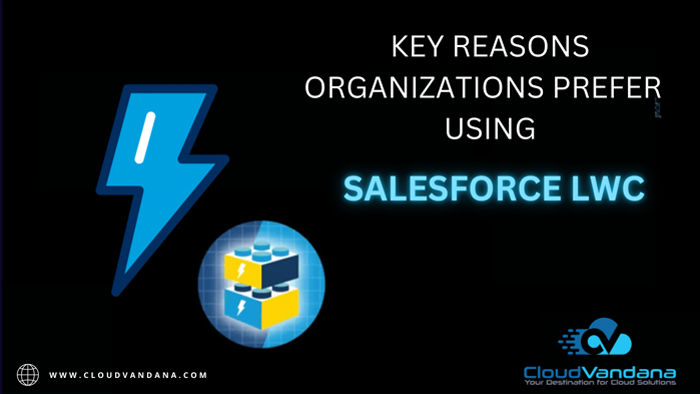
Salesforce LWC or Salesforce Lightning Web Component is a new programming model developed by the world’s #1 customer relationship management solution Salesforce. It is used to develop robust and responsive single-page UI-based applications for mobile and desktop. This new model co-exists with the Aura Components model and delivers unparalleled performance. In this blog, CloudVandana will discuss five key reasons behind the popularity of LWC or Lightning Web Components. The focus of this leading CRM is double the current revenue of organizations worldwide. People love this platform as it can be tailored to the requirements of businesses. In LWC, the required technical skillset is less framework-specific, so this CRM solution is opting for more developers to join the community. This programming model was introduced in December 2018 for building LWC. Developers can now create reusable components using the latest JavaScript innovations and web standards. Let’s dive into the details- Benefits Of Salesforce LWC 1. High Demand For Talent Finding the right talent is one of the major challenges for the tech industry. More developer talent would potentially reduce the pressure on some of the clients and partners who need more developers to support their requirements. LWC empowers developers to build web applications using standards-based tools with which they are comfortable. So, no-code and low-code development can be done seamlessly, which embraces the diversity of developer personas in the world. 2. Less Framework Support Previously, web developers had to learn the Aura framework before they could build Lightning components. When the platform launched the Lightning framework in 2014, it searched for the right programming model. But due to lack of availability, they released their own programming model, Aura, to support the framework. But the Aura framework came with its challenges. So, LWC was introduced, focusing more on web standards and less on the framework. 3. Aura & LWC Can Co-Exist With the introduction of LWC, Salesforce now has two programming models for building Lightning components. Aura and LWC components can be combined on a page and share the same data. Aura and LWC can both communicate with each other and their child components through events. Aura uses Application and Component events to communicate with child components or other Aura components. LWC uses Custom Events to communicate with Aura components. 4. Better Security Lightning Locker service is a security architecture for Lightning components introduced in 2016. This service enables security by wrapping each lightning component in its own container allowing developers to control access to APIs and framework internals. Locker service is enabled by default for all custom Lightning web components. Locker service aids developers in securing their Lightning we components by enabling JavaScript security best practices. 5. No More Developer Console Salesforce is promoting repository-based development that lets developers build components in their local drive and then push their code to the repository, scratch Org, or a Salesforce Org. By leveraging the latest web standards, such as JavaScript and CSS, Salesforce is providing specialized services for enhanced productivity and performance. With the introduction of LWC, Salesforce is making it easier for clients and partners to ramp up developers for their projects, helping them to provide better service and create a bigger path to achieving their goals. Are you looking for expert LWC resources to enhance your organization? CloudVandana, a reputed Salesforce partner, has introduced a new service, unlimited LWC, at a flat rate. Schedule a call now and share your requirements. Request a Free Consultation YOU MIGHT ALSO LIKE
A GUIDE TO HIRING REMOTE DEVELOPERS FOR STARTUPS

In today’s technology-driven business world, Remote developers for startups are the best option for entrepreneurs to stay ahead of the curve. But the increasing inconstancy and fluctuation have forced budding businesses to revisit their resource strategy. In this blog, CloudVandana will guide startups with the best practices for hiring remote developers for startups. While hiring developers for startups, organizations face various challenges. Let’s look at the challenges. 1. Lack Of Expertise Most startups do not have a full-fledged HR department. They generally operate with a small HR team with limited tools and experience, so it becomes difficult to find the right developers for an easy scaling process. 2. Limited Budget Most startups operate on a limited budget. But they need to deal with the monthly salaries of the in-house employees, the infrastructure cost, the cost of the work systems, employee benefits, etc. So the whole hiring process for in-house developers becomes a costly affair that startups can’t afford most of the time. 3. Lack Of Branding And Promotional Activities Startups generally lack brand recognition and awareness in the primary stage. So hiring skilled and experienced programmers for startups is tough. As developers or programmers usually work with known brands, attracting and retaining the right talent for the business becomes a complex process. 4. Long Hiring Process The long hiring process delays the whole project development, leading to increased time in deployment. To avoid these challenges, hiring offshore developers from an offshore development company like CloudVandana is a great option through which startups can hire the best team of developers immediately without any gap in the workflow. Benefits Of Hiring Remote Developers For Startups 1. Cost-Effective Solution Cost saving is one of the major benefits of hiring remote developers. Organizations can save hiring costs, infrastructure costs, and other employee benefits with this hiring process. Organizations can make contracts only for a specific project. They do not need to pay them their salary when there is no active project. So, a huge cost can be saved. 2. Faster Turnaround Time Hiring remote developers for a startup ensures a quick turnaround of the project as a team of dedicated experts working on software development. 3. Works Well On Both Short Term & Long-Term Projects Organizations can hire developers for both short-term and long-term projects. Based on the project requirements, organizations can hire an extended team for weeks, months, and even years. 4. Flexible Solution Organizations can enjoy the flexibility of hiring in a fixed, monthly, or hourly engagement model to meet the development requirements. Organizations can also create hybrid engagement by combining any models. 5. High-Quality Results Offshore remote developers are highly skilled and experienced. So high-quality development can be expected with outstanding code quality. 5 Useful Steps To Hire Remote Developers 1. Well-Defined Business Requirements Organizations should be specific about the project requirements while hiring the best developers. This will help them to easily complete the process. 2. Location Organizations should decide the country and city preference where they wish to hire the resources for the project. Organizations should consider the availability of resources in the specific technology, employment landscape, government stability, foreign policies, etc. 3. Engagement Model After shortlisting the location, organizations should decide on the best employment model for hiring an offshore team. If the project has a straightforward requirement, then the fixed cost may be the right choice. But if the development process requires constant updates and changes, then monthly or hourly engagement work best. 4. Shortlisting And Skill Test Organizations can make a contract with an offshore development company to shortlist the best candidate based on their experience, number of projects delivered, etc. The organization can assign a task to check their skill in that domain to ensure productivity. 5. Interview And Onboarding Interviews can be conducted over video calls to assess the technical, managerial, and soft skills. This can provide a holistic view of the developers. These interviews can assess the skills and personality of the programmers to check if this is the right fit for the company. After the selection, companies can move forward with the onboarding process. As the developers provided by the offshore development partner are well-trained, most of the time, organizations do not need to go for a training drive. So the candidates can join immediately without any work gap. Are you looking for the best team of remote developers for a faster and error-free deployment process? Please schedule a consultation call with the reputed Staff Augmentation partner CloudVandana and hire the best talent for your organization. Call Us Now. Request a Free Consultation YOU MIGHT ALSO LIKE
Why Organizations Prefer ReactJs For App Development

Organizations worldwide prefer ReactJs for App Development React as it is a free and open-source front-end JavaSript library and builds user interfaces based on UI components. Previously Angular was a default choice for many businesses, but presently, ReactJs is breaking records with its outstanding performance. In this article, CloudVandana will discuss the reasons behind the popularity of ReactJs for App Development. ReactJs For App Development It is a robust, self-explanatory, and open-source framework that can create accessible, short, single-page applications. According to a survey conducted by Stack Overflow, React environment ranked #1 while Angular stood #9 in terms of app development. Let’s discuss the advantages in detail- 1. Scalable JavaScript Development Tool The framework enables developers to include dynamic UI components in HTML, PHP, JavaScript, and other layouts in a scalable manner. It offers a variety of add-ons to enhance functionality and workflow. React developers use code to create interactive parts for their web applications, websites, and mobile applications. 2. Quick And Straightforward Solution The framework can create individual components that make up the broader UI and develop more sophisticated UI functionalities using basic HTML and JavaScript components. The framework can accelerate the loading of websites and apps by using Virtual DOM, allowing dynamic UI parts to update without reloading the page. The tools simplify application development. 3. Reusable Components The framework helps developers to get component reusability and code stability. The generic components can be reused anytime while maintaining without any extra effort. The reusable components are isolated, so they do not affect the functionality of other components. So a lot of time and effort is saved. 4. Easy To Learn The simplicity of this platform helps newbies to understand and work with it. So, developers with basic knowledge can work on this technology. So it is an easy option for every organization to make the most of it. Developers can easily use this framework as the framework doesn’t have multiple components. 5. Constant Community Support The framework has a vast and supportive community that is readily available to solve any challenges while developing an application. The community consists of expert developers around the globe who can help new developers every time they get stuck in the development process. There are endless other benefits of this framework that makes this the best choice for organizations. Are you looking for an expert React developer to experience every benefit to enhance their organizational process? Please schedule a call with CloudVandana, a reputed Staff Augmentation partner in India, and hire the best team of remote developers from the huge talent pool to upscale and up-skill your organization. Request a Free Consultation YOU MIGHT ALSO LIKE
TOP 7 REASONS TO OUTSOURCE SALESFORCE DEVELOPMENT SERVICES
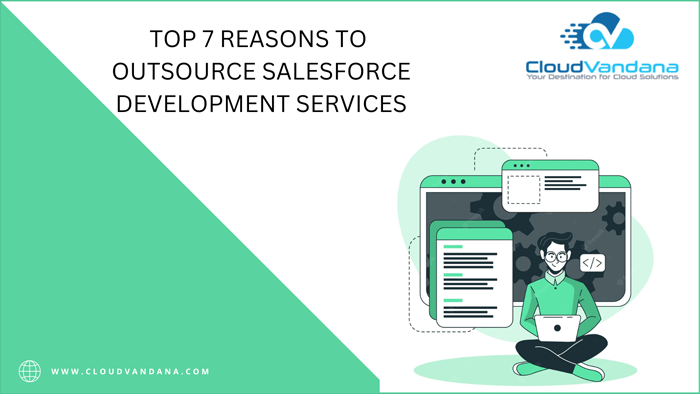
Outsourcing is essential for companies for a faster development process, but there are various other reasons to outsource Salesforce development services for organizations worldwide that want to stay ahead of their competitors. In this blog, CloudVandana, a reputed Salesforce Partner in India, will discuss the top seven reasons to outsource Salesforce Development Services. Let’s discuss this in detail. Outsource Salesforce Development Services Salesforce Development includes Apex, LWC, and Visualforce, which are technical. Most Salesforce features and applications are developed using this technology by skilled developers. Salesforce releases three updates each year. So, developers need to be updated every time. Most of the time, the in-house development team fails to perform the desired requirements, and hiring a new team of developers is a time-consuming task. So organizations prefer outsourcing development services. 1. Reduce And Control Operating Costs This process is very cost-effective and controls the operating costs of organizations like the hiring process, employee benefits, and possible turnover due to the strong demand for experienced professionals. 2. Gain Access To Expertise Managing this CRM platform requires a deep knowledge of features and configuration best practices. Gaining access to the skilled team of Salesforce-certified developers through a Staff Augmentation service provider like CloudVandana helps to accelerate the project timeline and ensures the work is completed within the scheduled time for faster deployment of the projects. 3. Helps To Focus On The Core Business Process With this outsourcing practice, businesses can focus on the core business or internal team to grow their businesses. The outsourcing company takes responsibility for the project work, so organizations do not need to take any load regarding this task. The experts can easily maintain every instance. 4. Find The Right Resources Easily Experienced developers are difficult to find, so the process includes a lot of time and resources. In addition, it is not possible to find the right talent locally. A staff augmentation firm provides remote resources who can start working immediately, maintaining a proper collaboration with the in-house team. It helps companies to scale and build the right project for specific business requirements. 5. Strategic Roadmap Salesforce Roadmap provides a clear view of the high-performance clients are generating more quality leads and pipeline opportunities. By creating a contract with a third-party developer, organizations experience access to business consultants and business strategists to help organizations with the best tool. 6. Helps To Bring Innovation Through Outsourcing services, organizations can work with talented resources. So they can bring various innovations to the organization and enhance the experience of the clients. So the reputation of the brand increases. 7. Helps To Increase Sales Revenue As per the statistics and analysis, companies can increase their revenue as the specialists add to the development of sales by establishing great client relationships. Companies can focus more on sales and the clients as the Salesforce Org. is managed by an expert team of developers. Are you looking for a reputed Salesforce Partner to outsource your Projects? Please visit www.cloudvandana.com and take the most relevant service based on your requirements. Call Now. Request a Free Consultation YOU MIGHT ALSO LIKE
5 KEY WAYS TO GUIDE THE SALES TEAM

An organization’s sales refer to the transaction between two or more parties that involves the exchange of tangible or intangible goods, services, or assets for money. In the financial world, a sale can also refer to an agreement that a buyer and seller make regarding financial security, its price, and specific arrangements for its delivery. So, the sales team plays an essential role in any organization. In this blog, CloudVandana will discuss the five effective ways to guide the sales team. Effective guidance not only helps representatives to improve productivity and efficiency to increase performance but enhances the organization’s revenue. Let’s look at the five essential ways to guide the team. 1. Encourage Self-evaluation Managers should encourage the salesperson for a proper self-evaluation. The managers’ goal should be to evaluate their performance and self-improvement goals. They should not jump directly into feedback during the interactions. Secondly, they should be ready to prompt the representatives with open-ended questions to help guide their self-evaluation. Self-awareness is the gateway to self-confidence, which can help lead to more constant sales. 2. Focus On Representative’s Wellbeing Mental health plays an essential role in productivity. Managers can create boundaries for the team. They can set clear work hours and guide the team not to schedule sales or internal calls outside the work hours. This practice will increase productivity. 3. Representatives Should Set Their Own Goals Coaches should let their representatives set focus areas for themselves. The managers can see if there is an important area that each representative wants to focus on and go with their suggestions. It creates an enhancement in the process. Based on industry benchmarks, managers can set a clear goal metric and timeline. An experienced manager can identify the strengths and weaknesses that help reps to fill in the missing pieces. 4. Managers Should Ask Representatives To Create Action Plans Open questioning during one-on-ones creates an environment where representatives can surface methods to achieve their goals. To make this plan solid, representatives can write out a plan of action that incorporates these methods. The plan should give an overview of the achievable steps to the desired goal with a clearly defined timeline. They should e sure to upload it to the organizational CRM as an attachment so that the document can be easily accessible by both the manager and the representatives. 5. Focus On One Improvement At A Single Time The representatives should work with one area at a time instead of multiple fields simultaneously. Working in various fields can end up in frustration. Over a year, managers can encourage them to practice various kinds of openings with other representatives. Leaders should ask them to assess their comfort level with call openings during one-on-ones regularly. These techniques will help organizations to enhance their sales process. Have you implemented Salesforce Sales Cloud in your organization for added advantages? Please feel free to schedule a consultation call with CloudVandana and leave the Salesforce implementation and maintenance process on CloudVandana to stay one step ahead of your competitors. Call Us Now. Request a Free Consultation YOU MIGHT ALSO LIKE
Salesforce DevOps Center To Enhance Development

Salesforce DevOps Center enhances the development process and reduces release cycles, and helps teams release technology solutions faster. Salesforce is the #1 CRM solution worldwide. Salesforce helps teams to release technology solutions faster, where organizations can reduce IT costs and deploy solutions faster to increase productivity. In this blog, CloudVandana, a reputed Salesforce partner in India, will discuss the Salesforce DevOps Center to enhance development. Salesforce has recently announced the general availability of a DevOps Center to help teams to release solutions faster and more efficiently. DevOps Center makes it easier to build, test, and deploy custom solutions across Salesforce-including automation, applications, and experiences-to that connect real-time customer data. DevOps Center brings improved tooling to build apps faster and more reliably across sales, service, marketing, commerce, and IT to deliver success. Genie Customer data Cloud delivers faster time to value so that IT teams can track the customization of Sales processes within the visual pipeline so that sales leaders can track every step of the project. Developers can use their preferred tools to customize out-of-the-box solutions to change source control. The extended team can see those changes in DevOps Center and iterate on them. Admins can build Flows within secure Sandboxes to automate customer support, while a programmatic developer extends the work with code in their sandbox, with DevOps Center orchestrating the changes to avoid challenges. CIOs can also use DevOps Center to quickly and easily build apps and Flows powered by the Genie Customer Data Cloud to understand and unlock customer data and deliver actionable insights in real-time. On the other hand, release managers can bundle and migrate changes across Sandboxes using clicks to deliver an enhanced patient experience without wrangling change sets. Let’s look at the key features of the DevOps Center. Key Features Of The Salesforce DevOps Center Teams can track and deploy the associated changes as work items-records on the new, custom object delivered with the DevOps Center application that can be operated against Flows and other platform operations. Companies can now easily create a pipeline that helps each team and associate states with sandboxes to build and test. This can be seamlessly integrated with Source Control. Teams can use clicks to connect DevOps Center to their version control system. It centralizes changes in the source and helps those who do not have experience with Git and branch management. So teams can enforce DevOps best practices and governance without any difficulties. DevOps Center automatically tracks the changes that teams make in their Sandboxes. Users can point and click to promote the desired metadata components. This helps to remove spreadsheets, sticky notes, and change sets to track changes. DevOps Center visualizes the entire development pipeline and enables teams to bundle and migrate changes from one state to another. The platform provides a low-code solution so all users can participate in the development pipeline and deliver business solutions. The Salesforce platform offers endless benefits that users can experience by implementing Salesforce CRM into their workflow to increase productivity and revenue. To get the best benefits of this platform, please schedule a demo with CloudVandana, a reputed Salesforce partner in India, and stay ahead of the competition. Call Now. Source And Image Courtesy: Salesforce Request a Free Consultation YOU MIGHT ALSO LIKE
5 KEY TIPS TO INTEGRATE SLACK INTO YOUR CUSTOMER SERVICE
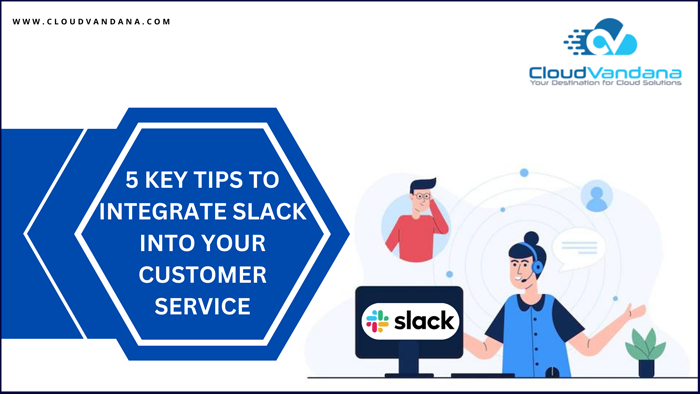
Slack is an instant messaging program designed by Slack Technology and owned by Salesforce. This platform helps users to communicate with voice calls, video calls, text messaging, media, etc. With the development of technology, teams have been attempting to interact with each other to overcome any challenges during an ongoing project and provide the best support to their clients. In this blog, CloudVandana will discuss five effective tips to integrate Slack into the customer service process. Businesses in the present time have already started to use Slack for customer support. The platform focuses on linking teams and organizing the entire business process to provide excellent customer service. This platform can be integrated with the Salesforce service cloud to bring customer support teams collaboration to access important customer information, critical data, and cross-functional partners. Key Tips To Integrate Slack Into Customer Support Communication tools support teams in meeting the requirements. They collect information about the client and the product to assist customers. So the team should always be able to communicate with other members to get quick assistance. Let’s discuss the benefits of this technology to support the customer service team. 1. Integrate With CRM and Project Management Solutions Users can integrate this technology to bring relevant information into Slack channels. The main feature of this platform is connectivity which enhances team organization. Now it is a comprehensive, collaborative platform with multiple integrations in the CRM and Project Management Space. Users can use various tools to manage customers, product roadmap, or incoming calls to integrate Slack to bring relevant information. 2. Implant Live Chat Currently, many customers expect live chat on a company’s website. The advantage of this technology is that numerous live chat platforms can be integrated with this platform to manage every customer inquiry. After the live chat integration, users can select a channel to deliver requests. Choosing a private channel is recommended to avoid any distractions. 3. Assistance Of The AI-Driven Knowledge Base AI or artificial intelligence is helping organizations to run their businesses efficiently. With the help of this technology, the customer service team can access a shared knowledge base without switching between various windows. The predictive search feature uses AI to display the most valuable content for resolving issues. Over time, machine learning and AI learn the kinds of queries the service team conducts to deliver the most useful information. 4. Integrate Messaging Tools Integrating Slack into the customer support software may save valuable time whenever customers ask for assistance or provide feedback through the various channels of the organization. So, users do not need to switch between applications without leaving this platform. Customer messaging applications and chatbots may be routed through this technology and managed on a single platform. It helps users or organizations to communicate with their clients directly. 5. Create A Slack Community Companies can develop free Slack communities for the public. Communities are an excellent way for consumers to assist each other in overcoming challenges. So every new customer is encouraged to join the community where they can share their thoughts and discuss the products. There are various other benefits that organizations can experience by integrating this technology into their workflow to make the customer service team more powerful. Are you looking for a Salesforce Staff Augmentation service to manage your projects efficiently? Please schedule a consultation call with CloudVandana, a reputed Staff Augmentation firm in India, and hire the best remote of remote developers from the huge talent pool to enhance your organization and stay ahead of the competitors. Call our executives now. Request a Free Consultation YOU MIGHT ALSO LIKE
10 EFFECTIVE LEAD GENERATION STRATEGIES FOR B2B
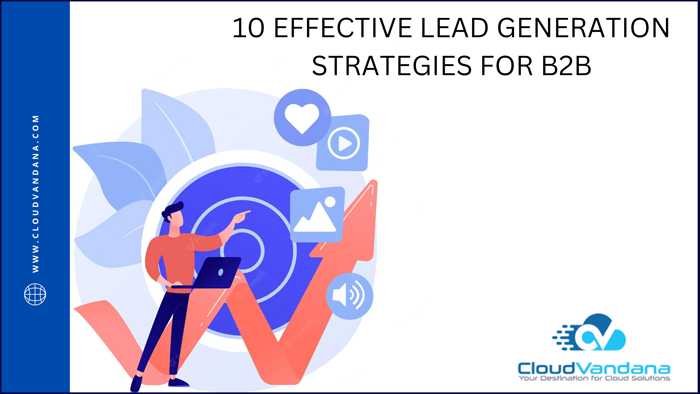
Lead generation is the initiation of consumer interest or inquiry into the products or services of a business. A lead is the contact information and sometimes demographic information of a customer that is interested in a specific product or service. B2B lead generation is business-to-business lead generation, which describes businesses that primarily sell to other businesses. In this article, CloudVandana will discuss ten effective strategies for B2B. This process involves collecting a potential customer’s information like name, email, company name, job title, etc., and using that information to target various ad campaigns. B2B is different from B2C lead generation, where products and services are directly sold to consumers. Let’s discuss the B2B Lead Generation Process- B2B Lead Generation Process To increase sales, organizations need a proper process. The B2B lead generation describes the process used by salespeople and marketing teams to turn prospects into paying customers. 1. Find The Leads The first step of the lead generation strategy is to find the information of potential buyers. Contact information is sourced in-house. 2. Reach Out To Leads Sales representatives can reach out to leads through social media, cold outreach, or replying to various inquiries. 3. Qualifying Leads After interacting with leads, representatives can measure how likely leads are to buy. 4. Close Deals After attending multiple meetings, when a prospect picks you, the deal becomes finalized. Now they are transferred into customers. B2B Lead Generation Strategy 1. A/B Testing Thousand of visitors browse various websites every day. Organizations can A/B test their web content to compare the best results. 2. Earn Buyers’ Trust With Social Proof Social proof is a powerful part of most B2B lead generation strategies. The more social proof the organization can gather on the site, the easier it becomes to build customer trust to increase sales. Organizations can add social proof to the landing pages, homepages, and other social handles, an excellent way to build the trust of prospects and customers. 3. Lead Generation Tools Organizations can use various lead generation tools available to get the best results. 4. Promote More Case Studies Case studies play an important role in the content creation process. But marketers should not let the case studies sit idle on the website. They should promote them in various ways. 5. Publish Original Research To generate More Sales When marketers publish the original content to the prospect, it can drive more sales as these practice help organizations build trust among the buyers. It will help them to become a respected authority in the industry, generate strong backlinks, and deliver value to potential customers. 6. Website Personalization Website personalization is essential to personalize the experience of the customers. The sales team can track the visitor’s journey and offer customized solutions for an increased conversion rate. 7. Lead Magnets Lead magnets are essential to the B2B lead generation process. A lead magnet can offer a prospect that has enough perceived value in exchange for contact information. 8. Optimize Long-Tail Keywords A long-tail keyword is three or more words long and is very specific. Targeting the right long-tail keyword, and you trade off search volume for extremely high purchase intent that increases sales with very little SEO effort. 9. Analyze Competitive Keywords Organizations should analyze the winning keywords to generate more leads. Organizations can take advantage of various SEO tools to drive more sales. 10. Organize Webinars One of the effective lead generation strategies is to organize webinars to capture new leads. A webinar is intended to engage customers, educate them on the products, and talk about the pain points to build trust. It is a great way to build relationships with them before purchasing the product. Are you looking for an effective customer relationship management solution to automate your sales process to generate more leads? Please feel free to schedule a consultation call with CloudVandana, a reputed Salesforce partner in India, and get the full ROI of your investment. Call Us Now. Request a Free Consultation YOU MIGHT ALSO LIKE
Why Your Business Needs Salesforce Managed Services
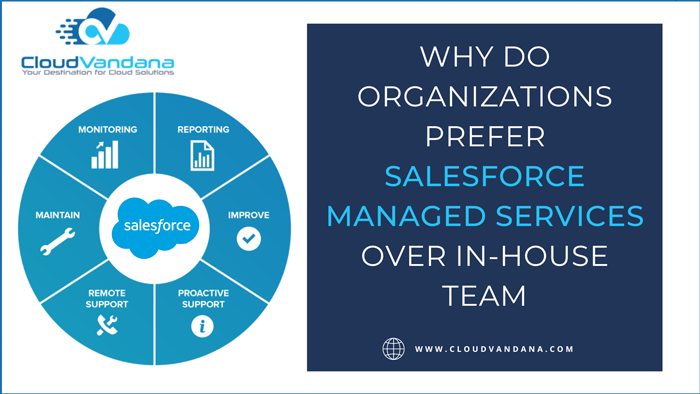
Salesforce Managed Services is the practice of outsourcing Salesforce‘s responsibility for maintaining a range of processes and functions for improved operations in reduced costs through the reduction of in-house staff. In this model, organizations generally contract a reputed Salesforce partner where the service provider performs on-demand services and charges based on the work done. In this blog, CloudVandana will discuss the reasons why organizations across the world prefer Salesforce Managed Services over an in-house team. Salesforce is such a platform that is continuously developing new features to streamline corporate procedures and cut down the amount of time needed to complete various tasks. So organizations globally are trying to maintain a competitive advantage to stay ahead of the crowd. Managed Services is an offering that helps organizations towards better success. The Salesforce partner takes all the responsibilities like implementation, planned resource allocation, risk prevention, and resolution. So companies can easily manage regular software updates, security audits, and many other Salesforce management responsibilities. Benefits Of Salesforce Managed Services This is an affordable and dependable solution and enhances the return on investment in the #1 CRM platform. 1. Scalable Solution Scalability is vital for every organization that wants to expand its business. When they choose Managed Services, they can be assured that the organizational requirements and demands will be given the most attention. As the process is scalable, organizations can easily scale up or down based on their organizational needs, which is not possible in the in-house hiring process. 2. Reduces Expenses This process reduces the operational costs that come with in-house hiring. Organizations can save time and money with managed service contracts. Organizations do not need to bear any recurring salary expenses. Instead, organizations will be billed on a per-service or per-hour basis so that organizations can easily scale their finance. Those charges are rather low when compared to the total cost of recurring expenses. 3. Innovative Capabilities Salesforce releases three updates each year. So sometimes, it becomes difficult for the in-house team to be updated with all the updates, changes, and various additional features. The outsourced resources are skilled and always updated with the latest innovations, so organizations do not need to arrange any additional training drive for the professionals. So, all the work can be done systematically. 4. Domain Expertise The process enables scalable access to professionals who can help to improve, maintain, and advance the installation and associated technologies. The hired professionals can help organizations to achieve their goals faster. This service can manage the ups and downs of business with efficiency and maturity. Are you looking for a reputed Salesforce Managed Service provider to enhance your organizational process? Please feel free to schedule a consultation call with CloudVandana, for every kind of Salesforce support and implementation process that will suit you the best. Call us now. Request a Free Consultation YOU MIGHT ALSO LIKE






